Humanizing Work 2013 Conference Recap
Last month’s Humanizing Work Conference was organized around one big hypothesis: that it was possible to do to a conference what we’d done to our classes—to take all the standard features and replace them with more interactive, brain-friendly ones. Well, it worked…beyond our expectations.
The Right Participants
Humanizing Work was an Agile For All alumni conference. All the participants had previously been in an class with Agile For All or one of our close partners like Rob Myers or Paul Rayner. This meant that everyone had a similar understanding of the Agile and Lean values, principles, and disciplines. Everyone was trying to apply these in their own context.
That shared background allowed sessions and conversations to focus on application of principles and on going beyond the basics.
And, as Geonetric CEO Eric Engelmann put it in his review of the conference,
The fact that the attendees had already been through Agile training with at least one of the coaches involved ensured that everyone was a high value attendee: we were all willing and aggressive learners, self-aware enough to look at what we’re doing critically and talk about the strengths and weaknesses openly. No posturing, no defensiveness, no wasted time in pointless debates.
Participant-Centered from the First Moment
As we planned Humanizing Work, we were resolved not to organize the conference around speeches and talks. We wanted to value participants’ knowledge and experience as highly as our own. Sessions had facilitators, but our role was to share models and drive discussions, not to be the main source of knowledge for attendees to absorb.
We built this participant-centered approach into the opening session. The main ballroom looked like your typical conference keynote setup: rows of chairs pointed towards a projection screen. But it wasn’t going to stay that way long.
As the official program started (at 9:02—even the times were unusual at this conference), Bob asked participants to pull out the playing card tucked behind their name badge. “This room isn’t set up for collaboration,” he said. “Please rearrange the room so you can work in groups according to the number on your playing card.” After a few minutes of apparent chaos, people were organized in groups around the room, some in circles of chairs, some sitting around low tables, others standing at high cocktail rounds. We handed a discussion question to each group and let them talk.


Each group had a different question. Here are a few examples:
- Can a single team deliver fully-functional features (or the non-software equivalent) in your organization? If not, why not?
- Is your Daily Scrum valuable? Why or why not? Would the other participants in the Scrum answer differently?
- Imagine you have a magic wand to make things better. You can’t make anything (or anyone!) disappear. What would you wave the wand at and why?
After about 10 minutes, Bob asked participants to look under their chair for another playing card and to shuffle their groups accordingly. Once they’d moved to a new group, they discussed the question left behind for that number. People had warmed up a bit with the first discussion, so this round was even more lively; it was hard to stop the conversations.
This second set of groups was for more than just a 10 minute discussion. As we closed the initial discussion, Richard explained that these groups would function as “learning groups” throughout the conference. At several points doing the conference, we’d ask people to get back together with their learning group to discuss what they learned in the previous session, some action they were going to take, etc.
Many people report that the hallway conversations are the best part of conferences they attend; learning groups built these conversations into the structure of the conference, rather than depending on them happening serendipitously. (It turned out that more unplanned hallway conversations happened than we’d ever seen before, probably because participants were already talking to each other throughout the conference.)
The Sessions
After the opening, we split into two parallel sessions. Most of the time, one session leaned towards Product Owners and the other towards ScrumMasters, although we didn’t see many people sticking to one track for the whole conference.
Each session was designed around the accelerated learning principles we use in our classes. The facilitator might lecture for 5-10 minutes in a 45 minute session. Our role was to provide just enough of an idea or model for the participants to reflect on their situation and learn from each other, not to be the center of attention. We used a variety of activities to drive interaction and concrete practice. Some sessions had more introspective table group discussions. In other sessions, groups would create new knowledge based on a model and present back to the rest of the room. Sometimes, we’d do a large group activity. Other times, participants would work on their own or in pairs.
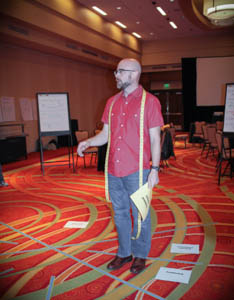
A few of the most well-liked sessions…
- “Talking to Executives About Agile” looked at content and approaches for conversations with executives who haven’t participated in agile training, what works and what doesn’t. The engagement in this session was so good that it ended up being continued during the emergent advanced topics time on Friday afternoon.
- “Focused Conversations” introduced the ORID model from *The Art of Focused Conversation* as a way to structure discussions and meetings, perhaps the single most useful facilitation tool we know. Five minutes into the session, participants were building their own focused conversations on a variety of topics. This session provided an interesting look “behind the curtain” for some participants, as they could see the focused conversation structure in many of the later sessions and discussions.
- “Morale and Team Building” collected an impressive set of ways to grow and maintain morale on Scrum teams.
- In the session on “Coaching,” Jake Calabrese facilitated an interactive discussion around Lyssa Adkins’s coaching model. As we talked with participants in one-on-one coaching sessions later, they’d sometimes stop us with, “So now you’re (mentoring|coaching|facilitating), right?”
 In the opening session on Thursday morning, Richard interviewed Eric Engelmann of Geonetric about their company-wide agile transformation. At Geonetric, just about everyone is on a cross-functional Scrum team, even roles like sales and marketing. It was clear that this session revealed new possibilities some people had never considered. It led to a lively emergent session on Friday about what happens when you mostly eliminate management (as a role) in an organization.
In the opening session on Thursday morning, Richard interviewed Eric Engelmann of Geonetric about their company-wide agile transformation. At Geonetric, just about everyone is on a cross-functional Scrum team, even roles like sales and marketing. It was clear that this session revealed new possibilities some people had never considered. It led to a lively emergent session on Friday about what happens when you mostly eliminate management (as a role) in an organization.
Each session produced flip charts of the knowledge created in the session, which became wallpaper for the main ballroom, radiating the learning that happened during the conference. It was fun to see people at breaks and lunches walking others through what happened in sessions they’d missed.
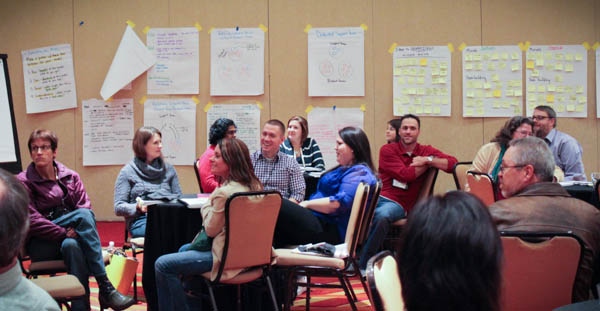
The final session on Friday morning turned out to be an unexpected favorite. We recognized that our accelerated learning approach favors verbal processing in pairs and small groups, but some people need time to process on their own. Usually, this happens in the week after a conference. Often though, life gets in the way, and the reflection never happens. So we decided to build it into the conference. In the “Future of Agile for You” session, we gave each person a handout with a set of focused-conversation-style questions and instructions to find a quiet place to use the questions to reflect on what they’d learned so far and how they wanted to put it into their practice in their work and life. Several people told us they wouldn’t have left with such a clear individual action plan without this session.
Perhaps our biggest mistake in the conference design was the session length. Most sessions were 45-50 minutes, which was far too short. We’d often have to break up a session just as great conversations were really getting going. Next year, we’ll do fewer, longer sessions. (But figuring out what to cut is going to be a challenge!)
The Conference Party
After the sessions wrapped up on Wednesday, the conference day was only partly done. At 5:15, limos pulled up in front of the hotel to take conference participants to The Fort, a uniquely Colorado restaurant in the foothills west of Denver.
We’ll let the photos from the evening speak for themselves:

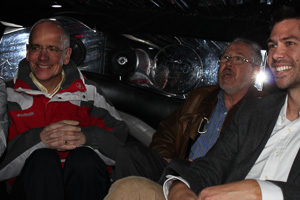
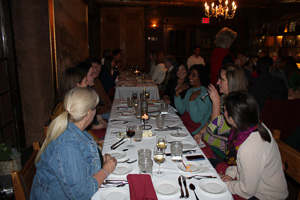
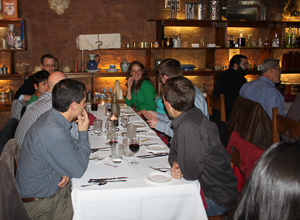
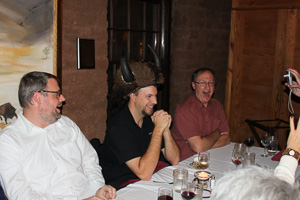

What’s Next?
We haven’t yet announced a date or venue for next year’s conference, but almost a quarter of this year’s participants have already registered for the 2014 event. One group has expressed an interest in being “next year’s Geonetric,” sharing a case study of the awesome things they accomplish with agile.
Assuming we can get the venue sorted out in time, we plan to announce Humanizing Work 2014 in early January, with registration fees going up each month until the conference. If you’ve been in an Agile For All class, public or private, and you don’t get our email updates, you can sign up here to be notified when registration opens:
If you’re not yet an Agile For All client and you’d like to be part of events like Humanizing Work, sign up for one of our public classes or contact us about private training and coaching for your organization. We’d love to hear from you.


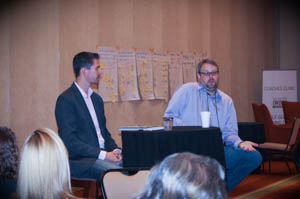 In the opening session on Thursday morning, Richard interviewed Eric Engelmann of Geonetric about their company-wide agile transformation. At Geonetric, just about everyone is on a cross-functional Scrum team, even roles like sales and marketing. It was clear that this session revealed new possibilities some people had never considered. It led to a lively emergent session on Friday about what happens when you mostly eliminate management (as a role) in an organization.
In the opening session on Thursday morning, Richard interviewed Eric Engelmann of Geonetric about their company-wide agile transformation. At Geonetric, just about everyone is on a cross-functional Scrum team, even roles like sales and marketing. It was clear that this session revealed new possibilities some people had never considered. It led to a lively emergent session on Friday about what happens when you mostly eliminate management (as a role) in an organization.


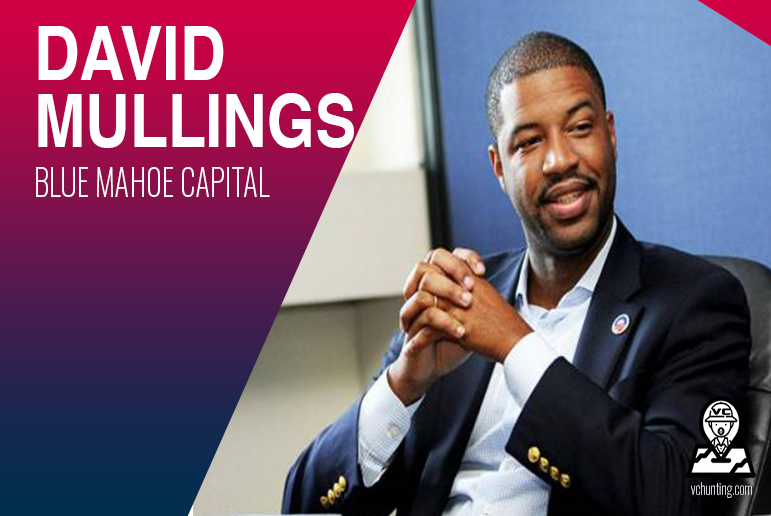
Responses